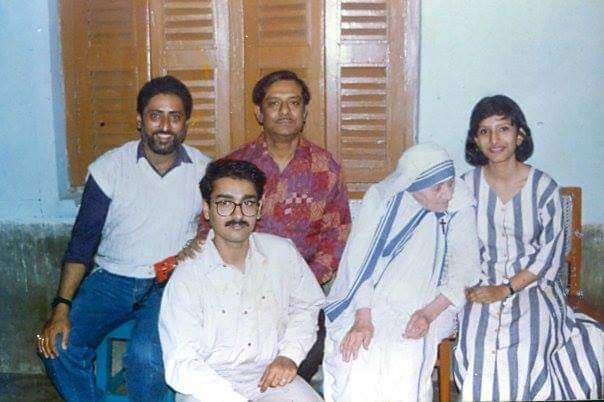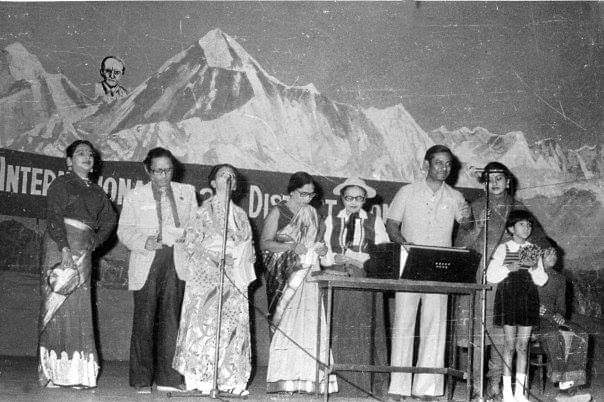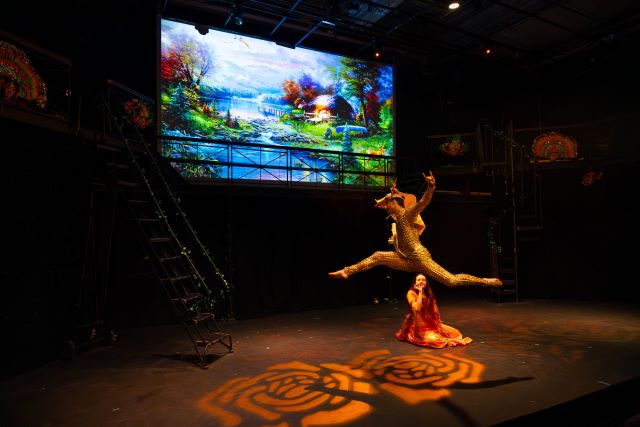
The Indian-Americans
From the Pandals of Bengal to American Theater
A traditional village Ram Leela transforms into ‘Ramaavan’, an off-Broadway musical
[dropcap]I[/dropcap] love immigration stories – of how people recreate themselves and thrive in a new country. Rimli Roy always had a passion for the arts, and growing up, she often performed with her family in Kolkata. She however, trained in the tech industry and came to the US as an IT professional in 1999. When work projects seem to vanish after 9/11, she decided to open a dance school. Over the years this grew into a performing arts center and this Diwali she brought her labor of love ‘Ramaavan – the musical’ to the Off-Broadway stage. It is an English adaptation of the epic Ramayan and incorporates verse, Indian dance, opera and jazz along into the mix. Ramaavan is co-presented with the Indo-American Arts Council (IAAC).
She says: “Original versions/treatments of the story, I thought, were laced with racism, biases and preconceived notions and eventually became only about good and evil, man and god, or black and white. To relate the story to the world today, I felt it important to delve into the grays, beyond religion, background, biases, differences and give it a more human perspective. Each and every character, just like us humans, deserved a rightful platform to tell their story.”
Rimli’s musical is still very much a work in progress and here she talks about how it evolved from the Puja pandals to the off-Broadway stage, and how with color-blind casting, she incorporated all Americans into the Ramayan epic.
Kolkata to New York, a story of Immigration, Roots and Replanting

What are your memories of Diwali and Durga puja and other cultural events?
I was born and raised in the heart of Kolkata, which many consider to be the cultural capital of India. I moved to the U.S at the end of 1999.
In Bengal, Diwali and Kali Puja are celebrated at the same time with great pomp and vigor. Bengalis worship the all-consuming mother goddess of Shakti – Kali, who is believed to be the destroyer of all evil and negative energies so new life can evolve. Kali is believed to be none other than another form (or avatar) of the goddess Durga – the mother who protects her earthly children from harm’s way.
Durga Puja is the largest and most popularly celebrated festival in Kolkata where artisans showcase their best talents by creating life size, world-class pandals (a temporary – usually ornate and artistic – structure where the deity is housed) and handicrafts for the occasion. There was also usually a winner for the best pandal and deity, so all the incredible artists ended up vying for that prize.
My best memories of Kolkata include days celebrating Durga Puja, Kali Puja and Diwali with friends and family over delectable food, fireworks, new clothes and cultural performances. Kolkata came alive with displays of fancy street lights in each neighborhood and pandal hopping (by foot) would be a common activity. Traffic was very restricted during this time because of the large crowds that gathered.
As an artist, I would often find myself performing on stage during this time though I would also have plenty of time to just have fun.
One of my favorite things to do during Durga puja was to perform the Dhunuchi dance in front of the deity of the goddess mother. The Dhunuchi is an incense filled earthen pot with a handle which one holds during the time of worship or offering.
Tell me about the home atmosphere which encouraged you to take on an arts career.

I was luckily born into a family of artists (and academicians) so I grew up with music, dance and visual arts around, while also receiving an education from one of the finest schools in Kolkata. I trained in various art forms (Indian classical dance – Bharatnatyam, Manipuri and Odissi, Hindustani classical vocals, harmonium, Western classical piano, visual arts) from a very early age. I started training in dance and Hindustani classical vocals from the age of four.
My father, Sumit Roy is a renowned composer, performer and musician from Kolkata who is well-versed in both Indian and Western music. My mother Arati Roy is a writer, lyricist and visual artist and it is for her perseverance that I had to diligently take my arts training seriously (as seriously as she did want me to take my academics being a science student). In fact, Surati is named after my parents Sumit and Arati who are my biggest inspirations in this journey.
My older brother Rajesh Roy is a filmmaker, musician, performer and composer who has also greatly influenced the artist in me with his constant guidance in music (and math!). I was also extremely involved in the arts and other extracurricular activities through elementary, middle and high school days leading several initiatives in both music and dance.
My training has been in Indian classical dance forms – Bharatnatyam (Purnima Ghosh), Manipuri (Khelendra Mukhopadhyay, and briefly with Ranjana Jhaveri of the Jhaveri sisters) and Odissi (Guru Giridhari Nayak), Western Classical Pianoforte (Trinity College of Music, London), Hindustani classical vocals and harmonium (Moni Biswas).
I am extremely grateful for the opportunities and experiences in my formative years as I found myself touring with both my father and my gurus for performances within India and abroad and also performed on National television during that time. I am also an AIR (All India Radio) artist for vocals and piano. After graduating college, I was working in Mumbai in the IT industry while also working briefly as a choreographer in the Bollywood film industry and with Zee Television channel for a dance based TV show just before I moved to the U.S.
Kolkata is one of the most cosmopolitan cities in India and is also considered the cultural hub of India. I have memories of attending countless concerts, plays, exhibitions, performances, book fairs, panel discussions, debates with my parents, as well as in school. I have also performed extensively with my father and brother throughout my school and college years, singing, choreographing and also playing keyboards and percussions in their band.

I have memories of waking up at 2 am in the morning with the sounds of the piano as my father was playing for his friends and colleagues who decided to stop by for an impromptu music session at our home. I recall now (with a smile) my brother being asked by my father to play the piano the night before his final exams, for visiting guests, much to my mother’s chagrin (who was obviously trying her best to balance our studies and the arts at home). At my home in Kolkata, guests were welcome at any time and there would always be music and food overflowing.
It is also important to note that my parents themselves came from very different backgrounds, however, I was never coerced into following any rituals or practices at home. It seemed a choice I was free to make. It was only Saraswati, the goddess of music, arts, enlightenment and learning, that we were taught to worship in our home.
Whether it was artists or school friends, we were never taught to treat anyone differently in the extended community we belonged to. I remember my father inviting visiting artists from other countries to our home for more music and celebrations. I learnt that art had no distinctions or boundaries or language barriers. In school too, we were one family irrespective of differences culturally, ethnically or in background. We were truly secular in every aspect, and embraced each others unique differences with love and respect.
This definitely had a big impact on my life personally and as an artist as I moved to the United States with that same spirit, beliefs and values. Establishing Surati as a color blind, inclusive organization is something I am very proud of today and helps me carry on the legacy of where I come from.

Was it hard starting your own dance school?
Honestly, even though I had been performing my entire life, I had never thought I would begin a career in the arts when I first moved to the U.S. In fact I had originally moved to the NY area (in Jersey City) as an IT professional. Although I started rehearsing and performing almost immediately over weeknights and weekends as soon as I moved in, I was definitely not prepared for a switch in my career. I was active in the local cultural groups, performing with other dancers in the area but they were not really my students at that time.
It was only after 9/11 when I was waiting on new IT projects that I started teaching dance and incorporated Surati in 2002. The nonprofit was incorporated in 2012.
It is often misunderstood, but Surati was always conceived as a professional performing arts organization and production company (not a dance school). Because communities knew me as a dancer, many assumed it is primarily a dance school.
The performances I have directed, choreographed, curated and toured nationally and internationally with have always involved a professional team of artists, dancers and musicians, not students or amateurs, unlike most dance school models.
Yes, Surati also has a School of Performing Arts and several local community performances may be curated by our instructors and performed by our students but that is only a small section of our overall operations. For teaching, we are currently working with several Arts-in-Education programs bringing Indian cultural experiences to educational institutions like schools, universities, libraries and museums.

Since we started producing our Holi festival as a platform for local artists and to bring the community closer, focus has shifted and attendees are able to gauge the entire scope of our work. Our mission however remains the same – that is to globalize Indian culture, stories and festivals transcending boundaries of race, gender, ethnic backgrounds and discrimination.
Initially, it was challenging for me to establish Surati independently. With very limited funding through our start-up classes, community performances and County grants, we managed to survive. Over the years however, we have been able to get funding for our work from the NJ Department of Tourism, Dance NYC, NJ Arts and Culture Renewal Fund, Jersey City Arts and Culture Trust Fund, Hudson County Office of Cultural, Heritage Affairs and Tourism.

How did the musical Ramaavan evolve?
Ramaavan first found its roots in Surati’s original production “Tyohaar – Festivals of India” which traced the history of each Indian festival (holiday) and its significance / relevance today. As part of the story of Diwali, we originally began depicting the story of the Ramayana through dance, music and drama with narration in English. Tyohaar was first performed in 2007 at Brookfield Place (then called the World Financial Center Wintergarden) and later also at several venues including at the Lincoln Center in 2012. Since then I have been developing the retelling of this ancient story and its first versions only had danced storytelling, drama and a couple of songs borrowed from others.
Over the years, it evolved into becoming a unique musical with elements of Indian classical dance and music, opera, musical theater, jazz, flamenco and contemporary genres.

Why is it so important and how are you transforming it from a Ramlila to an off-Broadway play?
This version of the Ramayana is extremely important to me as an artist, humanitarian and community leader as it brings together artists and crew from diverse backgrounds to tell one of India’s greatest epic tales through artistic genres from India as well as from around the world. It undeniably resonates with my background, upbringing, perceptions and values. The environment I grew up in taught me the true meaning of being inclusive, respectful and tolerant irrespective of man-made boundaries and differences. The Ramayana, I believe, could have been a story from any land, as it teaches universal values and morals that people across generations can relate to. It is also a literary masterpiece that unfolds the story of Diwali. I valued the cultural and educational significance of the epic and wanted to interpret it through my beliefs and values, using the forms of art I had learnt, seen, appreciated and learnt to respect.
Growing up in India, I was exposed to several versions of the Ramayana or Ramlila (mostly traditional) over the years, be it on stage, television or radio. I was always fascinated by mythology and intrigued by the stories particularly from the Indian diaspora, and of course by the Ramayana. Even though the story is marvelous, somehow, the traditional treatments of it did not appeal to the artist or storyteller in me.
Original versions/treatments of the story, I thought, were laced with racism, biases and preconceived notions and eventually became only about good and evil, man and god, or black and white. To relate the story to the world today, I felt it important to delve into the grays, beyond religion, background, biases, differences and give it a more human perspective. Each and every character, just like us humans, deserved a rightful platform to tell their story.
I have seen several interesting takes on the Ramayana but in Ramaavan, I never wanted to deviate from the storyline, but instead, add various layers and insights to the treatment and look deeper into each character. As a believer of god and good lies within us humans, I felt the need to revisit the story and interpret it my way, not through the earlier depictions.

I truly loved and admired the characters in the story and with the changing times, I did not want to lose the very important messages and morals within it, especially for the generations to come. For the audience is likely to see the unfolding of events through the eyes of the storyteller or director. I knew I would not be able to do justice to the musical if I wasn’t convinced of the characters or events myself so I needed to move away from previous depictions of the classic and reimagine the story on my own seeing it through my lens. As I conceptualized the retelling of the story from an unbiased, human perspective, I found the section where Ram and Ravan intersect the most interesting, hence the birth of Ramaavan – A Musical. The story of prince Ram and King Ravan. I also realized I would like to end this version with the significance of the story of Diwali. I felt the need to share this beautiful story originating in my country using genres from around the world as that best depicted my vision and artistry for the story. A diverse cast furthers our mission to educate a global community and I feel honored to have a cast every year who have embraced indian culture and the story just as we have embraced them and the art forms they have brought to the production
The script and lyrics are in English verse, bringing a never-before seen version of the classic introducing the audience to poetry and rhyme This musical has also paved the way for Indian classical dancers and musicians to be part of an off-Broadway musical, a mainstream production that can now be appreciated by a wider audience. I have also used Indian handicrafts and craftsmanship heavily in the scenic design of the show creating opportunities for artisans and folk artists to showcase their work. For eg. I have used chhau masks and pipli handicrafts as part of backdrop scenes. I have also conceptualized and designed one of the ornate backdrops with a pandal artist in India who also built the structure. This piece was specially shipped to the U.S from Kolkata.

After Ramaavan – what?
This year has been our most fulfilling experience with Ramaavan – A Musical, with the current version being what we could best recreate given our limited scope, space and funds. The musical is still only about ten percent of my vision in terms of grandeur, cast / team size and execution. We strive to seek funding constantly to be able to continue to take it to the masses and to mainstream communities and garner long term support for this classic epic.
My ultimate goal would obviously be to tour this show nationally and internationally along with script translations where needed. Whether it makes it to Broadway or remains only a touring musical remains to be seen, but it’s heartwarming to receive rewarding comments from the audience and press every year, which gives us the hope and strength to carry on with our mission of cultural experiences and storytelling.
Apart from Ramaavan, I am planning several other productions and musicals in the future, most being rooted in Indian myth and classics. One original concept is an Arts meets Science project that highlights solar energy, the environment and world peace which I also want to make into a musical.
I think Indian culture, performing arts, handicrafts and stories are rich in content and scope and can have the ability to captivate audiences worldwide with the appropriate visibility, funding and artistry. It is this conviction that gives me strength to keep enhancing productions like Ramaavan – A Musical and create new works.
